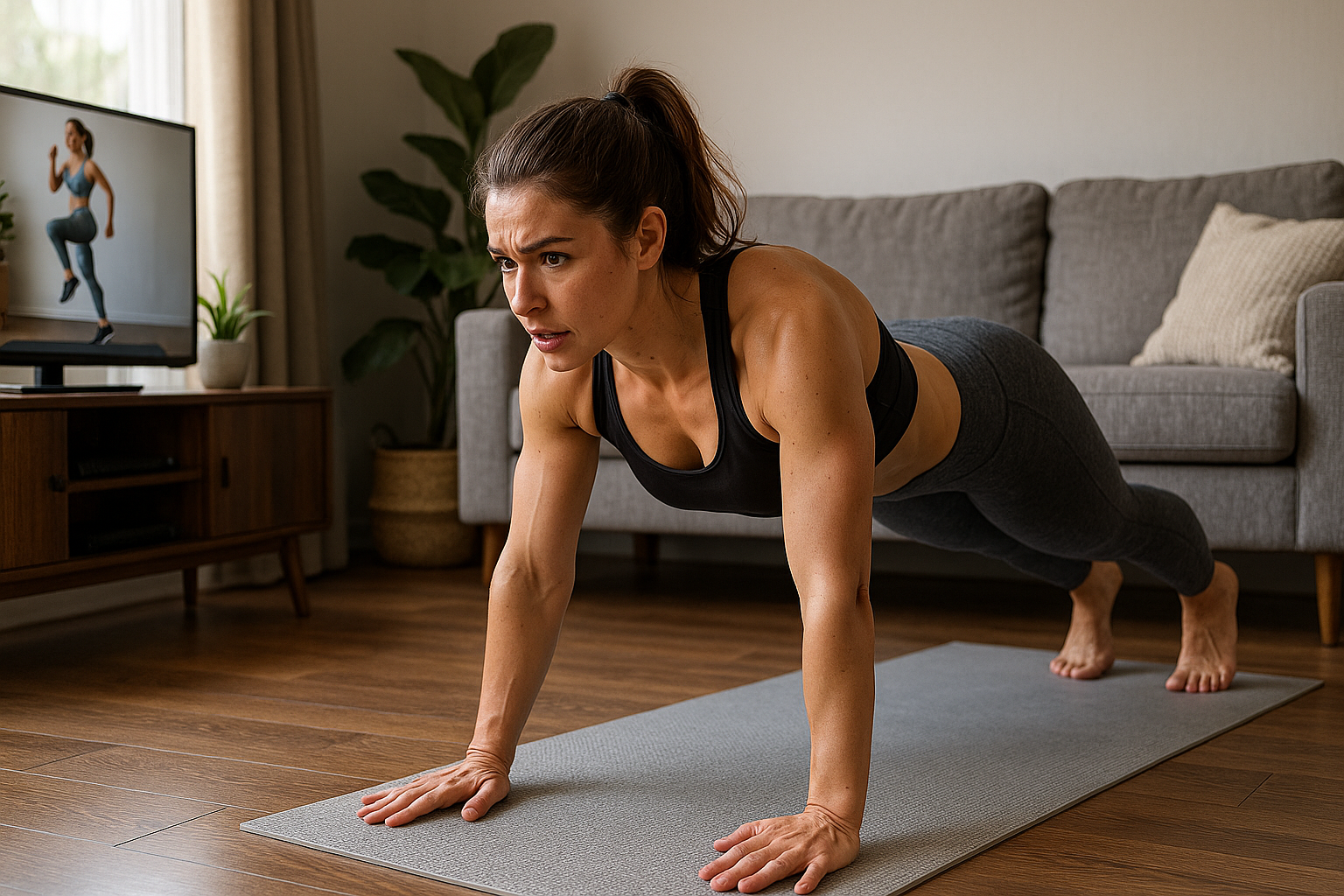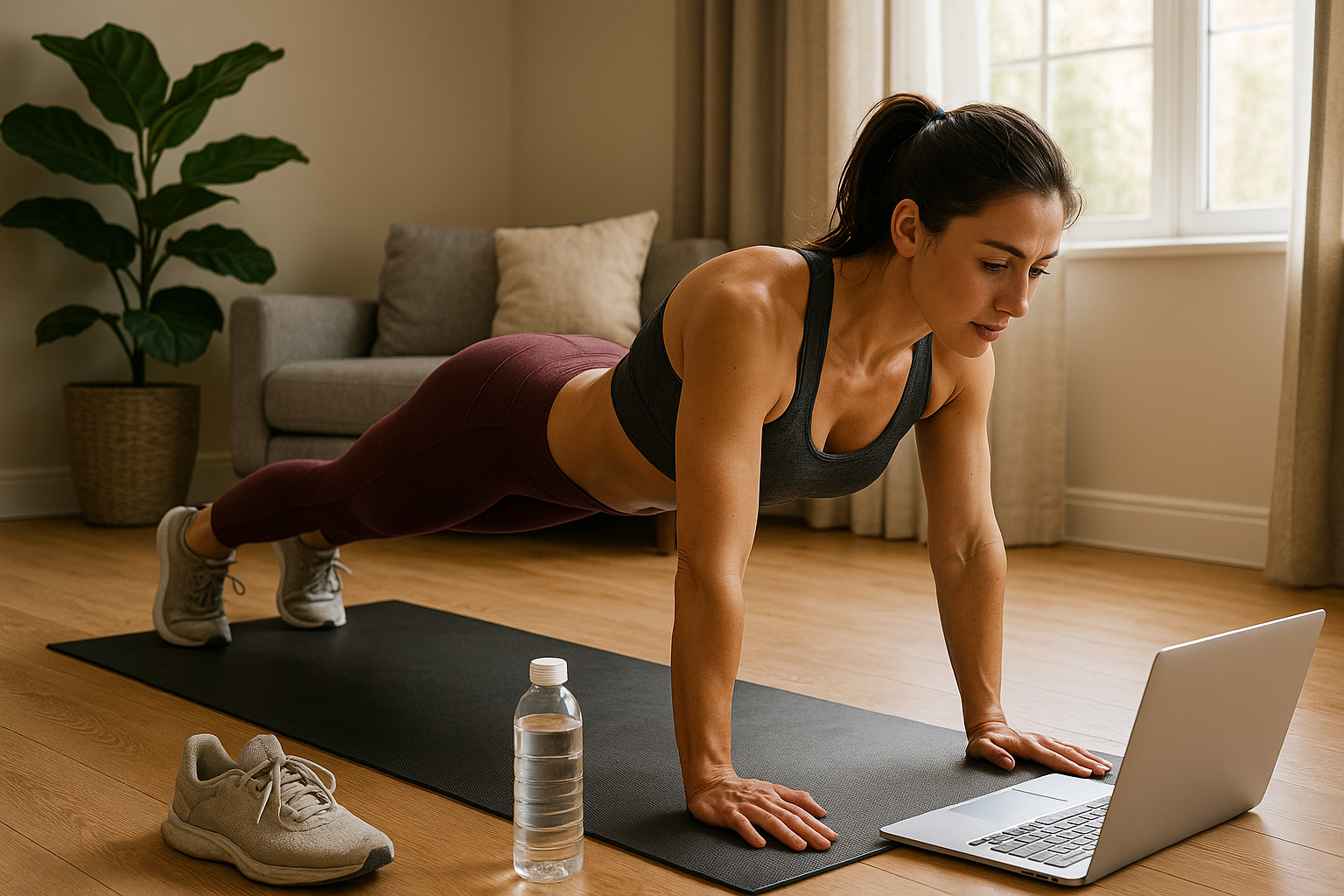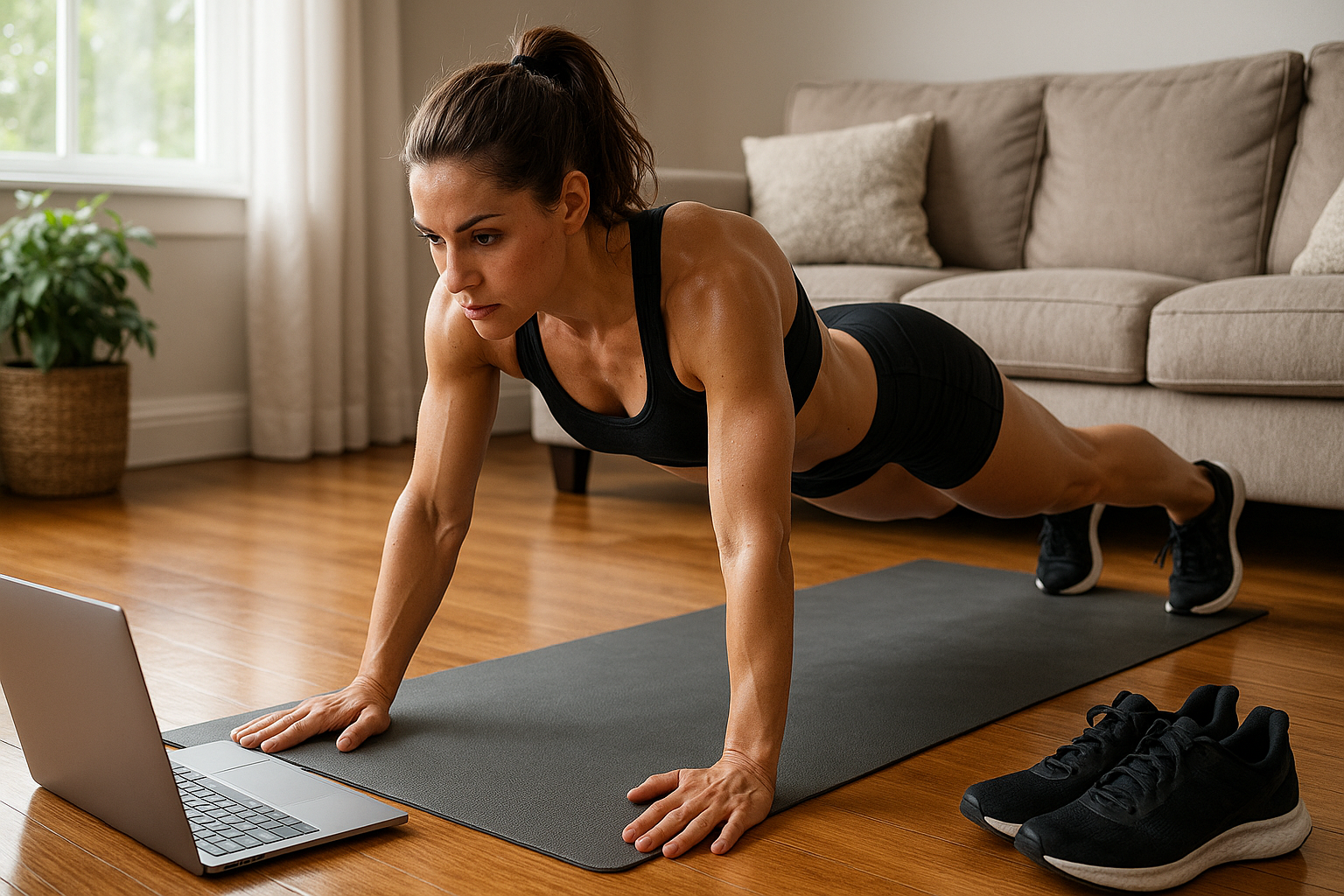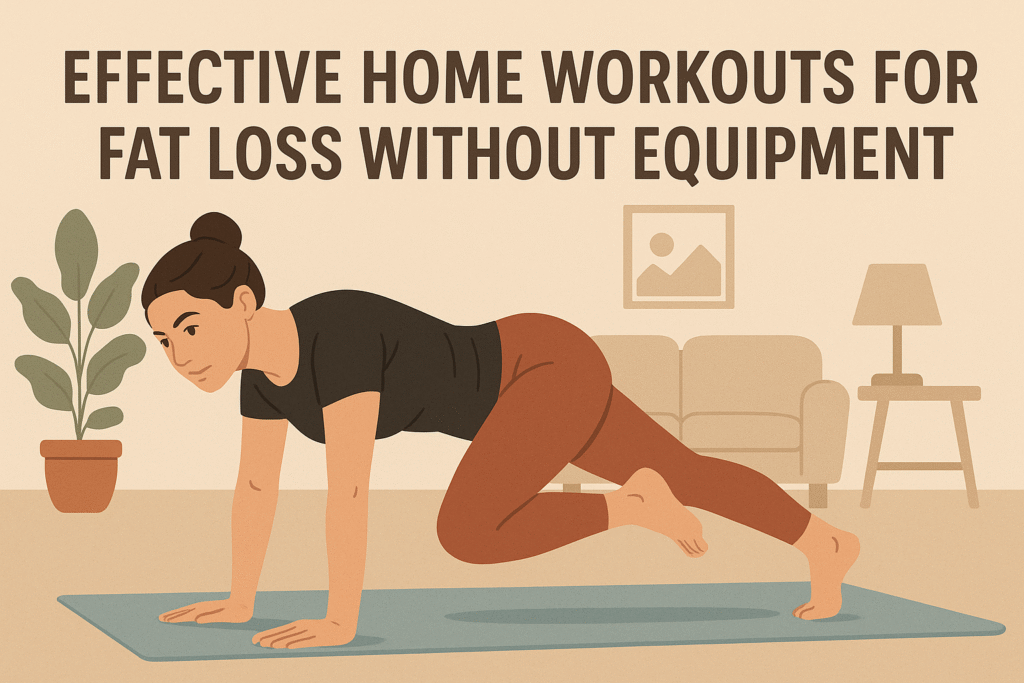Introduction
Losing fat at home without equipment is entirely achievable with the right combination of movement, intensity, consistency and nutrition. You don’t need dumbbells, a treadmill or a gym membership—bodyweight exercises and smart programming can create the calorie burn and metabolic stress that drive fat loss while improving strength, endurance and mobility.
How fat loss works (brief)
Fat loss is primarily driven by a sustained calorie deficit—burning more energy than you consume—while preserving muscle helps maintain metabolic rate and shape. Exercise contributes by increasing energy expenditure, boosting metabolic rate after workouts (especially higher-intensity work), and helping you retain or build lean mass. The most effective home workouts mix resistance-style bodyweight moves and higher-intensity intervals to maximize results in limited time.
Benefits of equipment-free home workouts
– No cost, high accessibility — you can train anywhere.
– Functional strength and movement patterns translate to daily life.
– Time-efficient: intense, short workouts can deliver big results.
– Flexible progressions: make bodyweight exercises harder as you improve.
Essential bodyweight moves to know
Include multi-joint, compound movements for the most metabolic and strength benefit:
– Squat variations: bodyweight squat, narrow/wide stance, sumo squat
– Lunge variations: forward, reverse, walking, Bulgarian split squat (rear foot elevated)
– Hip-dominant moves: glute bridge, single-leg glute bridge, hip thrust (using a bench)
– Push patterns: push-ups (knees, standard, decline), pike push-ups
– Pull alternatives: inverted rows under a sturdy table, towel rows, hip-hinge + posterior chain emphasis
– Core: plank (front and side), hollow body hold, mountain climbers, dead bug
– Explosive/cardio: jump squats, burpees, tuck jumps, high knees, skater hops
Warm-up and cool-down
– Warm-up (5–8 minutes): light cardio (march/jog in place, jumping jacks), dynamic mobility (leg swings, arm circles), and movement prep (bodyweight squats, lunges, shoulder taps).
– Cool-down (5–8 minutes): light walking or slow marching, static stretching for major muscle groups, deep breathing to lower heart rate.
Sample workouts (time-efficient, no equipment)
Beginner full-body (20–25 min)
– 2 rounds circuit, 40 sec work / 20 sec rest each station; 60–90 sec between rounds
1) Bodyweight squats
2) Incline push-ups (hands on a chair)

3) Glute bridges
4) Plank (on knees if needed)
5) Marching in place (or low-impact high-knees)
– Finish: 60-sec slow walk + stretch
Intermediate HIIT strength (30–35 min)
– Warm-up 5 min
– Circuit A: 3 rounds, 45 sec on / 15 sec off
1) Jump squats
2) Push-ups (standard)
3) Bulgarian split squats (alternating)
4) Mountain climbers
– Rest 90 sec between rounds
– Core finisher: 3 rounds of 30 sec plank / 15 sec rest
– Cool-down
Advanced metabolic conditioning (40–45 min)
– Warm-up 6 min
– EMOM 20 (every minute on the minute for 20 minutes) — alternate two movements:
Minute 1: 12–15 burpees
Minute 2: 20 walking lunges (10 per leg) + 10 pike push-ups
– Then 3 rounds of: 45 sec single-leg glute bridge each leg / 15 sec rest
– Cool-down and stretch
Tabata options (4 minutes of intense work — great for conditioning)
– 20 sec work / 10 sec rest x 8 rounds: choose one move
– Burpees (advanced)
– Jump squats (intermediate)

– Mountain climbers (beginner to intermediate)
Use 1–3 Tabatas within a workout for a potent metabolic boost.
Programming tips: frequency and split ideas
– 3 full-body sessions per week: ideal for beginners and for maximal recovery while creating a large weekly stimulus.
– 4–6 sessions per week: split into strength-style days (2–3) and higher-intensity cardio/conditioning days (1–3). Example week:
– Mon: Full-body strength circuit
– Tue: HIIT (20–25 min)
– Wed: Active recovery or mobility
– Thu: Strength + core
– Fri: Tabata or longer LISS (30–45 min brisk walk)
– Sat: Short metabolic circuit
– Sun: Rest or gentle activity
Progression strategies (to keep getting results)
– Increase volume: add sets or rounds.
– Increase intensity: shorten rests, increase work time, add explosive moves.
– Increase difficulty of movements: single-leg or asymmetrical variations (pistol progressions, one-arm push-ups).
– Add tempo changes: slow eccentric (lowering) phases to increase time under tension.
– Track performance goals: more reps in the same time, more rounds completed, or reduced perceived exertion at given work.
Nutrition basics to support fat loss
– Aim for a sustainable calorie deficit: commonly 300–500 kcal/day below maintenance for steady fat loss without undue muscle loss.
– Prioritize protein: roughly 1.6–2.2 g/kg body weight per day supports muscle retention during a deficit.
– Spread protein across meals and include protein at each meal.
– Carbohydrates can be timed around workouts for performance; healthy fats for satiety and hormones.
– Hydrate—thirst can masquerade as hunger.
– Avoid extreme diets and aim for consistent adherence; small, sustainable changes beat drastic short-term fixes.

Recovery and sleep
– Sleep 7–9 hours per night where possible; poor sleep undermines appetite regulation and recovery.
– Include at least 1–2 full rest or active recovery days per week.
– Monitor stress—chronic stress raises cortisol and can impede fat loss.
Tracking progress
– Use multiple markers: weekly weight (trend over time), body measurements, how clothes fit, progress photos, and performance metrics (reps, rounds, workout times).
– Expect non-linear progress; aim for consistency over weeks and months rather than day-to-day changes.
Safety and common mistakes
– Form over speed: rushing through reps increases injury risk and reduces effectiveness.
– Don’t neglect mobility and prehab—tight hips, shoulders or poor ankle mobility will limit movement quality.
– Avoid excessive cardio alone; combine resistance-like bodyweight work to protect muscle mass.
– If you have pre-existing conditions, severe joint pain, or cardiovascular concerns, consult a healthcare professional before starting a new program.
Quick workout examples you can try tomorrow (20–30 minutes)
– 20-minute AMRAP (as many rounds as possible):
10 air squats
8 push-ups
6 walking lunges (3 each leg)
30-sec plank
– 25-minute interval:
5-min warm-up
10 rounds: 30 sec burpees / 30 sec rest
5-min core (3 x 30 sec hollow hold)
Cool-down
Closing note
Effective fat loss at home without equipment is about consistency, progressive challenge, and the right nutritional approach. Use structured sessions (strength + conditioning), monitor intensity, prioritize recovery, and make nutrition sustainable. With time, these habits will yield measurable fat loss and meaningful improvements in fitness and daily function.

